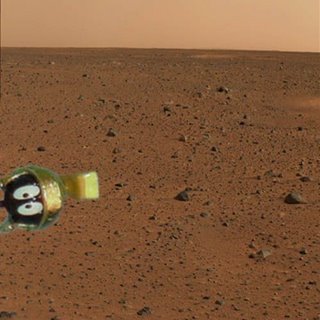
"Where's the kaboom? There was supposed
to be an earth-shattering kaboom!"
Well, here we are -- I guess, I assume we are here, if you are reading this -- six sixty six came and went much like Y2K but without the opportunity for as much fanfare, anxiety-production or computer security scams.
One must bear in mind, however, what the late, great philosopher Sun Ra meant when he spake unto us saying, "It's already the end of the world, don't you know that, yet?"
He meant, of course, chronon theory. Chronon theory is one of the odd jewels in the higher intellectual altitudes of speculative physics. And it's not really new, just revived like everything else from the Greeks and improved with contemporary technology. Chronon theory basically uses complicated Western science to get at an Eastern precept; that the universe, or that-which-is-perceived-to-be-what-we-commonly-agree-to-call-"reality," is getting created and destroyed all the time, through Shiva's little rhumba. That is, with every blip on of a chronon, All is Called Into Being, and with every blip off, All Is Extinguished. And All may not always come together again like it was before, which explains missing socks in the laundry, lost car keys, mysterious disappearances of the television remote, and the vanishing promises of politicians after election time.
If chronon theory is correct, it would go a long way to understanding the role of randomness and time itself. Can anything be predicted -- especially if everything is nothing until it is everytbing again? Walter Heisenberg and Neils Bohr thought maybe not, as they debated Albert Einstein about their Uncertainty Principle. Albert Einstein famously blurted, "I cannot believe that God would choose to play dice with the universe." Bohr replied, "Einstein, don't tell God what to do." Niels Bohr (says the Wikipedia) himself acknowledged that quantum mechanics and the uncertainty principle were counter-intuitive when he stated, "Anyone who is not shocked by quantum theory has not understood a single word."
"The basic debate between Einstein and Bohr (including Heisenberg's Uncertainty Principle) was that Einstein was in essence saying: "Of course, we can know where something is; we can know the position of a moving particle if we know every possible detail, and thereby by extension, we can predict where it will go." Bohr and Heisenberg were saying the opposite: "There is no way to know where a moving particle is ever even given every possible detail, and thereby by extension, we can never predict where it will go."
This may also be part of a way of explaining how there could be not just one universe, but many. Quoting from The Big View.com:"Andrei Linde at Stanford has brought forward the cosmological model of a multiverse, which he calls the "self-reproducing inflationary universe." The theory is based on Alan Guth's inflation model, and it includes multiple universes woven together in some kind of spacetime foam. Each universe exists in a closed volume of space and time."
Edgar Allan Poe, who considered himself a Richmonder by the way, came up with this particular theory in his little studied Eureka (1848) in which he tried explaining life, the Universe and everything using the language of a mid-19th century essayist. Note that each of Dr. Linde's universes "exists in a closed volume of space and time."
Poe puts it like this, with bolded emphasis mine:
" Let me declare, only, that, as an individual, I myself feel impelled to the fancy -–without daring to call it more -–that there does exist a limitless succession of Universes, more or less similar to that of which we have cognizance -–to that of which we shall ever have cognizance -–at the very least until the return of our own particular Universe into Unity. If such clusters of clusters exist, however -–and they do -–it is abundantly clear that, having had no part in our origin, they have no portion in our laws. They neither attract us, nor we them. Their material -–their spirit is not ours -–is not that which obtains in any part of our Universe. They could not impress our senses or our souls. Among them and us -–considering all, for the moment, collectively -–there are no influences in common. Each exists, apart and independently, in the bosom of its proper and particular God."
Dr. Linde and Dr. Guth are far less florid in their approaches, but that's science.
So there could be a limitless succession of universes, winking in and out, created and destroyed. Their interior characteristics are unpredictable. Maybe. To get all New Agey, perhaps each universe is no more than a quantum, and a quantum, a universe.
Now pour yourself a drink and think about that for a minute.
It's already the end of the world, don't you know that, yet?


1 Comments:
This comment has been removed by a blog administrator.
Post a Comment
<< Home